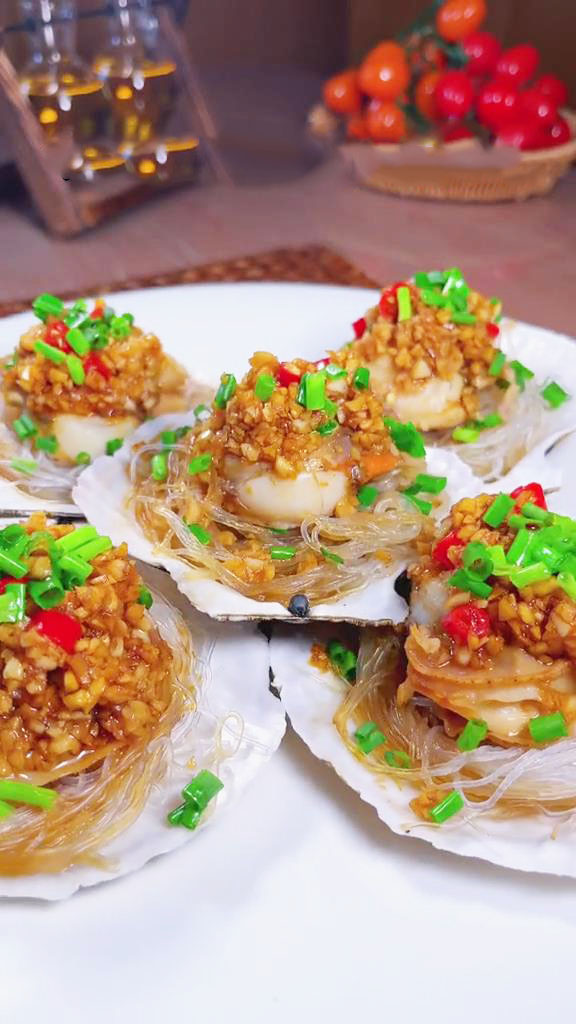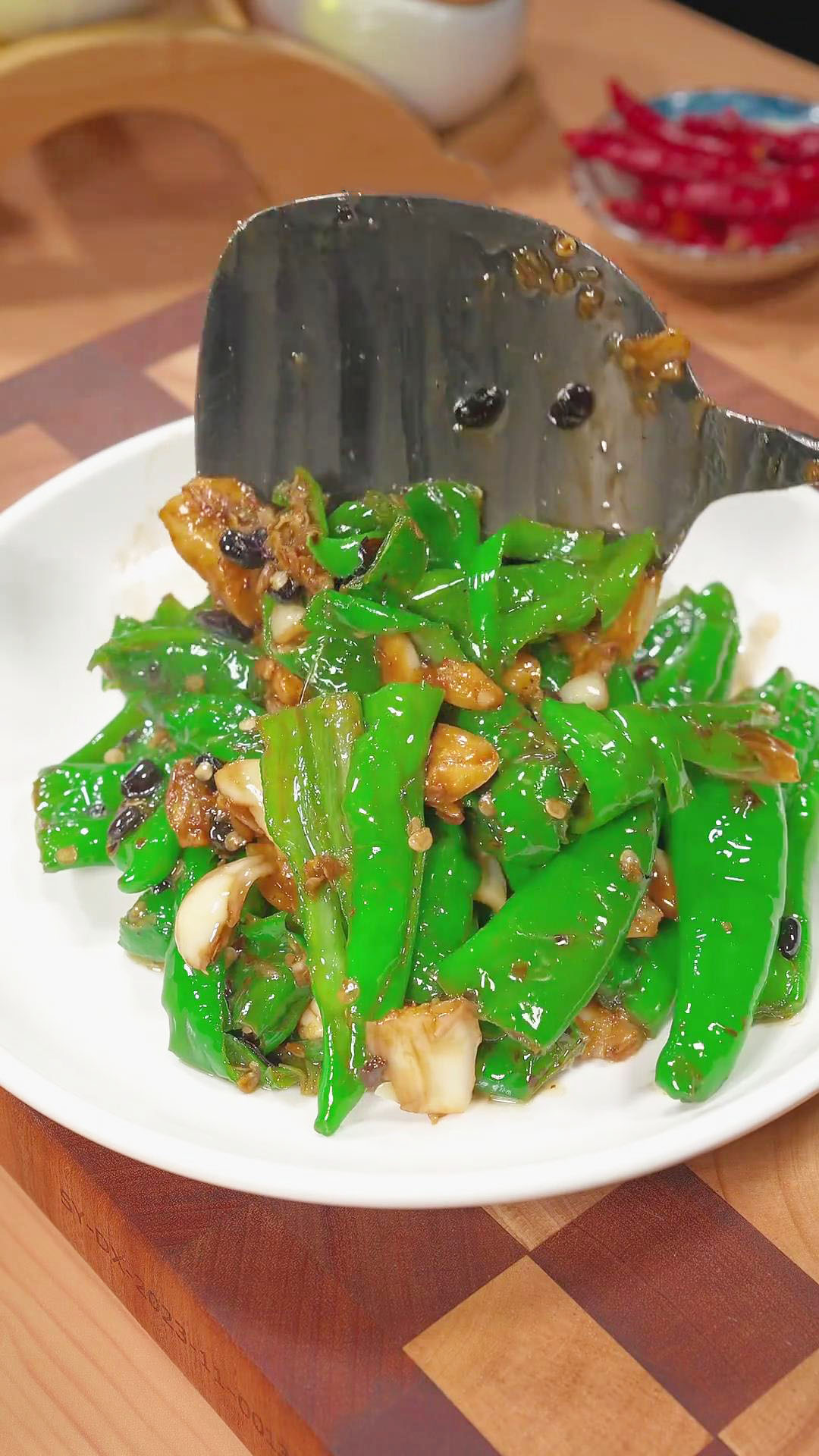This Taiwanese pork belly rice bowl is so mouthwatering that it melts in your mouth. Enjoy the tender and fatty fried pork belly strips simmered in several spices and seasonings. Not only is pork belly the highlight of this dish, but the additional delicious elements, such as boiled eggs, shiitake mushrooms, and fried shallots.
What Is Lu Rou Fan?
If you loved my Taiwanese recipes such as Taro Bubble Milk Tea, you should also add Lu Rou Fan or Taiwanese pork belly rice bowl to your recipe collection. It is a popular comfort food because of how easy it is to make it. It may require a lot of spices and seasonings, but they are common grocery items that you may probably already have in your pantry.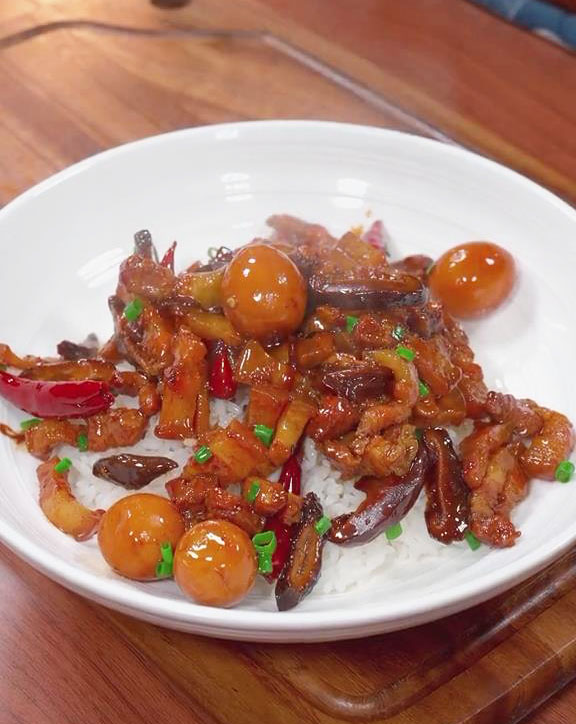
The recipe steps are super easy: Just fry the pork belly and simmer it in a deeply flavored broth with boiled eggs, fried onions, and shiitake mushrooms. Of course, you will have to cook the eggs and fried onions separately before combining them. To complete your rice bowl, top the dish on white rice and pair it with a side of your favorite vegetables.
Enjoy the melty pork belly pieces as you munch on a sweet and savory glaze. It is definitely a complete meal with a combination of meat, vegetables, and carbs. In case you missed my other pork belly recipes, here they are:
- Crispy and Easy Pan-Fried Pork Belly
- Chinese Cured Pork Belly (Lap Yuk/Chinese Bacon)
- Air-Fried Crispy Pork Belly
- Juicy Air Fryer Pork Belly
- Crispy Pork Belly (Burger)
- Cantonese Roast Pork Belly
- Pork Belly Char Siew
- Kimchi Pork Belly Stir-fry
- Chinese Steamed Pork With Water Chestnuts
What To Know About The Ingredients Of Lu Rou Fan
With the combination of spices and seasonings used for this dish, the flavor profile you are going for is a balance of sweet, salty, savory, earthy, and umami. It is supposed to be tender and chewy with the pork belly slices and mushrooms, as well as crumbly with the hard-boiled eggs. Follow my ingredient tips and alternatives below to get the right taste and texture for your Lu Rou Fan.
- Pork belly: Pork belly is a boneless part of a pig’s stomach with layers of fat. Get it with the skin on, either in slabs or strips. When choosing pork belly, make sure the fatty layers are white, not gray or yellow. The cut should also have an even thickness to cook consistently in the pan. I don’t recommend replacing this with other pork cuts since you need a cut with fatty layers for a melty, luscious finish.
- Shredded onions: Traditionally, Lu Rou Fan incorporates fried shallots for their enhanced flavor and crunchy texture. While pre-made fried shallots are available in stores, I highly recommend preparing them at home using my recipe for Fried Shallots In Oil. This homemade version offers superior freshness and flavor, elevating your dish to another level. Additionally, the infused shallot oil adds a delightful aroma and depth to various dishes, including beef wonton soup. For this recipe, I opt for red onions as they are more readily available and offer a similar sweetness and mild peppery taste to shallots. You can slice the red onions into julienne strips or rings, depending on your preference. When caramelizing the onions, ensure they reach a rich brown color without burning.
- Green onion: You will need a knot of green onions to add a mild sweetness and oniony taste to the broth. Swap green onions with chives or scallions if needed.
- Ginger: Ginger adds a peppery and sweet kick to the broth. You can swap fresh ginger with ground ginger, about 1/4 to 1/2 tsp ground ginger for every 1 tbsp of fresh ginger.
- Star anise: You will love star anise for its licorice-like taste and strong aroma contribution to the dish. Its taste is warm, woody, and sweet. Alternatives for this star-shaped spice are anise seeds, Chinese five spice, allspice, fennel seeds, and cloves, which you can all read in my guide: The Best Star Anise Substitute | Top 5 Substitutes.
- Cinnamon: I added cinnamon sticks for a touch of woody, spicy, and citrusy taste. Substitute cinnamon sticks for cinnamon powder, Chinese five spice powder, nutmeg, Allspice, or cloves.
- Dried chili peppers: You can turn this into a spicy dish by adding dried chili peppers. Add as much as you want, depending on your preferred level of heat. You can substitute this with chili flakes or cayenne pepper. If you are not a fan of spicy food, simply omit this from the recipe and make the dish savory only.
- Bay leaves: Just 2 pieces of bay leaves can add notes of thyme and oregano flavors. You can swap this with dried oregano, thyme, or basil, but the taste will not be completely the same.
- Cooking wine: Chinese cooking wine adds a slightly sweet and briny taste. You can omit this if you prefer alcohol-free or simply use a non-alcohol wine. Use Shaoxing rice wine, cooking sake, dry sherry, or red wine vinegar.
- Light soy sauce: Incorporating light soy sauce gives the dish a deep umami and salty taste. Use regular soy sauce, tamari, liquid aminos, coconut aminos, or gluten-free soy sauce.
- Dark soy sauce: For a rich dark color, add a bit of dark soy sauce. It also lends a hint of sweetness and umaminess. If you want to replace it with the closest substitute, swap it with mushroom sauce, double black soy sauce, teriyaki sauce, or more oyster sauce and adjust to taste.
- Oyster sauce: Oyster sauce is umami, salty, and briny, not fish-tasting. It is similar to soy sauce mixed with barbecue sauce. You can substitute this with hoisin sauce, kecap manis, teriyaki sauce, Worcestershire sauce with soy sauce and sugar, and oyster-flavored sauce.
- Rock Sugar: If you have noticed, rock sugar is commonly used as a sweetener because it is more diluted. It is less sweet than white or brown sugar, perfect for savory dishes. If you don’t have rock sugar, use white sugar, brown sugar, or coconut sugar, and adjust to taste.
- Boiled eggs: Boiled eggs are one of the last ingredients to add before simmering the dish on low heat for 30 minutes. You can use any size of regular hen eggs or quail eggs. These are cooked separately and boiled until hard-boiled eggs. If you’re unsure how to achieve this, you can refer to my tea egg recipe for detailed instructions on making hard-boiled eggs. However, if you prefer soft or medium-boiled eggs, you may not be able to combine the eggs during simmering since they will continue to cook and still turn hard-boiled. If you really prefer soft or medium-boiled, I suggest adding the eggs after simmering the pork belly in the sauce. Then, simply add the eggs and give it a gentle mix with the saucy pork belly dish. The slight downside of this alternative step is that the eggs won’t be fully immersed in the sauce and won’t absorb the flavors as much. Aside from boiled eggs, you can also use fried eggs with a runny yolk.
- Soaked dried shiitake mushrooms: Shiitake mushrooms are my go-to mushrooms if I want to add something smoky and meaty. I prefer dried shiitake mushrooms over fresh ones since they have a deeper flavor profile and a chewy texture. If using dried shiitake mushrooms, these should be rehydrated first by soaking in hot water. You can use other types of mushrooms, such as button mushrooms, portobello mushrooms, and king oyster mushrooms.
- Garnish: Apart from decoration purposes, chopped green onions as a garnish lend a fresh oniony taste. You can also use cilantro as a garnish.
- Oil: You will need oil when frying the red onions. For frying pork belly, you won’t really need oil since the pork belly has fats that will melt and serve as oil. Any cooking oil with a high smoke point will do, such as avocado oil, peanut, canola, or corn oil. Use olive, avocado, sesame, or safflower oil for a healthier option. If you want a neutral taste, go for peanut, soybean, or vegetable oil.
- Optional ingredients: This dish is salty and savory, so you will definitely need fiber and greens to counter it. Use blanched or stir-fried vegetables of your choice, such as bok choy, broccoli, yu choy, or spinach. If you want to alter the taste, you can incorporate the following:
- Minced garlic or garlic powder for a garlicky taste
- Chinese Five Spice Powder for a warm, licorice-like taste
- White pepper powder for a musty taste with subtle heat
- Sichuan peppercorns for a numbing effect
What You Need To Make Lu Rou Fan
You just need one non-stick pan or pot for frying the onions and pork belly, boiling the eggs, and simmering all the ingredients together. Of course, prepare your regular kitchen items like a knife and spatula. Here are the ingredients you need:
- 300g of pork belly
- 2 tbsp of Oil
- 1 red onion (julienned)
- 1 knot of green onions
- 5 ginger slices
- 1 piece of star anise
- 1 cinnamon stick
- 8-10 dried chili peppers
- 2 pieces of bay leaves
- 1 tbsp of cooking wine
- 1 tbsp of light soy sauce
- 1 tbsp of dark soy sauce
- 1 tbsp of oyster sauce
- 1/4 cup of rock sugar
- 12 or more boiled eggs
- 6 pieces dried shiitake mushrooms (rehydrated and sliced)
- 2 bowl of boiling water or adjust as needed
- Chopped green onions for garnish
How To Make Lu Rou Fan
It may be a lengthy process, but the recipe will be a breeze once you have all the ingredients cooked and ready! Simply prepare the fried onions, fried pork belly, boiled eggs, and rehydrated shiitake mushrooms. Put everything in the pan and simmer with all the spices and seasonings.
Watch these steps with my short tutorial video on Instagram or TikTok. What do you think of this recipe? Share your reviews by leaving a comment in the comments section.
- Slice the pork belly into strips, aiming for a uniform thickness of approximately 5mm and width of 10mm to ensure even cooking in the pan.

- Heat oil in a pan and stir-fry shredded onions until they turn brown and caramelize. Set them aside. You can use store-bought fried shallots, or follow my Fried Shallots recipe to replace the fried shredded onions.
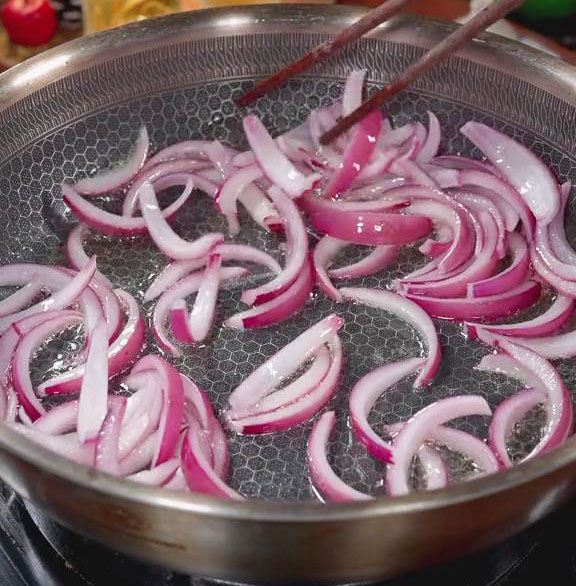
- Prepare the other ingredients.
- Boil the eggs for 10 minutes and peel off the shells. Set aside.
- Soak the dried shiitake mushrooms in hot water until fully rehydrated. Drain the water and set the mushrooms aside. This step should be done in advance. Alternatively, you can rehydrate the dried shiitake mushrooms in cold water overnight to prepare them ahead of time.
- Take the pork belly strips and stir-fry them in the pan over medium-low heat until they turn brown. If using a non-stick pan, no additional cooking oil is needed. However, if using a wok, preheat the wok and then add 2 tablespoons of cooking oil before adding the pork belly.
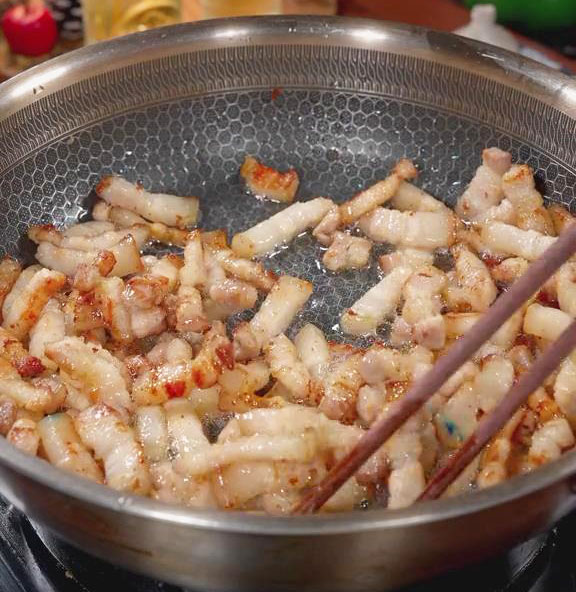
- Add green onions, ginger, star anise, cinnamon, bay leaves, and dried chili peppers. Mix well.

- For seasoning, add cooking wine, light soy sauce, dark soy sauce, oyster sauce, and rock sugar. Stir-fry until the sauce thickens and caramelizes. By this time, the pork belly turns reddish brown in color.
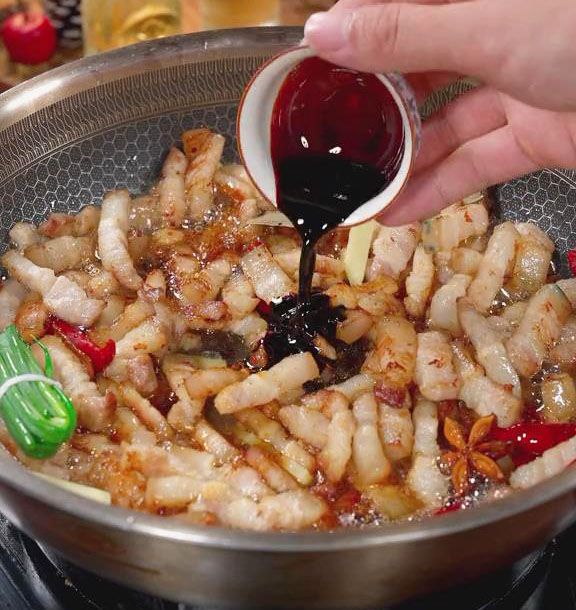
- Add the crispy fried onions, boiled eggs, and soaked shiitake mushrooms.

- Pour freshly boiled water into the pork belly dish, ensuring that the water completely covers the ingredients. Cover the dish and simmer over low heat for about 30-60 minutes. It’s important to maintain low heat to allow the sauce to thicken gradually without burning or drying too quickly. You can simmer it longer if needed, especially if the sauce has not yet thickened to your desired consistency. Stir gently 2-3 times during cooking to prevent sticking to the bottom of the pan.
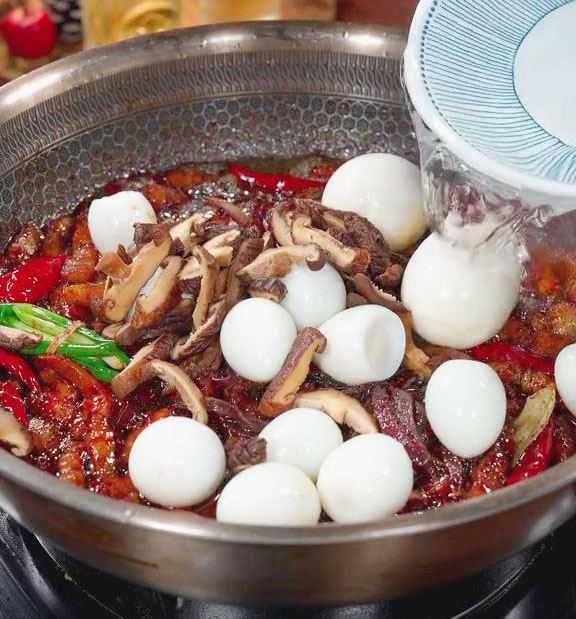
- Garnish with chopped green onions. Top this dish over hot white rice and don’t forget to pair it with vegetables.
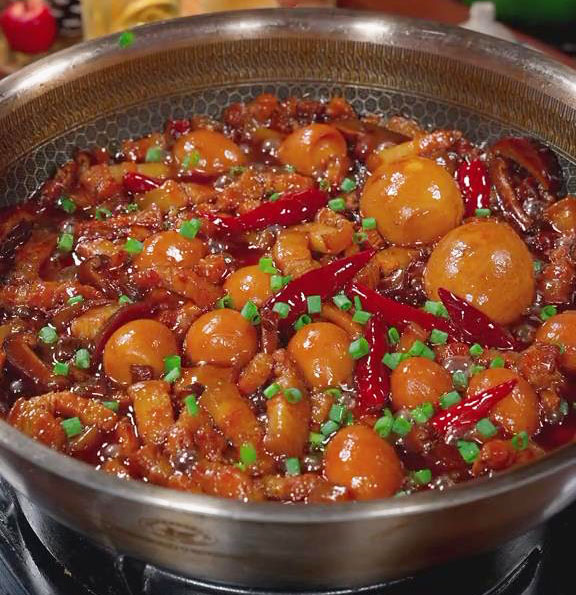
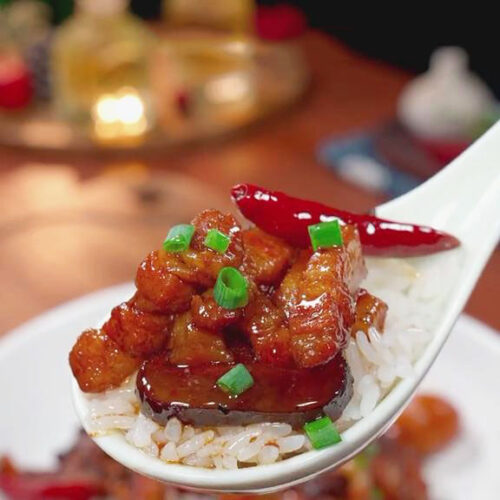
How To Make Lu Rou Fan
Ingredients
- 300 g of pork belly
- 2 tbsp of Oil
- 1 red onion julienned
- 1 knot of green onions
- 5 ginger slices
- 1 piece of star anise
- 1 cinnamon stick
- 8-10 dried chili peppers
- 2 pieces of bay leaves
- 1 tbsp of cooking wine
- 1 tbsp of light soy sauce
- 1 tbsp of dark soy sauce
- 1 tbsp of oyster sauce
- 1/4 cup of rock sugar
- 12 or more boiled eggs
- 6 pieces dried shiitake mushrooms rehydrated and sliced
- 2 bowl of boiling water or adjust as needed
- Chopped green onions for garnish
Instructions
- Slice the pork belly into strips, aiming for a uniform thickness of approximately 5mm and width of 10mm to ensure even cooking in the pan.
- Heat oil in a pan and stir-fry shredded onions until they turn brown and caramelize. Set them aside. You can use store-bought fried shallots, or follow my Fried Shallots recipe to replace the fried shredded onions.
Prepare the other ingredients.
- Boil the eggs for 10 minutes and peel off the shells. Set aside.
- Soak the dried shiitake mushrooms in hot water until fully rehydrated. Drain the water and set the mushrooms aside. This step should be done in advance. Alternatively, you can rehydrate the dried shiitake mushrooms in cold water overnight to prepare them ahead of time.
- Take the pork belly strips and stir-fry them in the pan over medium-low heat until they turn brown. If using a non-stick pan, no additional cooking oil is needed. However, if using a wok, preheat the wok and then add 2 tablespoons of cooking oil before adding the pork belly.
- Add green onions, ginger, star anise, cinnamon, bay leaves, and dried chili peppers. Mix well.
- For seasoning, add cooking wine, light soy sauce, dark soy sauce, oyster sauce, and rock sugar. Stir-fry until the sauce thickens and caramelizes. By this time, the pork belly turns reddish brown in color.
- Add the crispy fried onions, boiled eggs, and soaked shiitake mushrooms.
- Pour freshly boiled water into the pork belly dish, ensuring that the water completely covers the ingredients. Cover the dish and simmer over low heat for about 30-60 minutes. It's important to maintain low heat to allow the sauce to thicken gradually without burning or drying too quickly. You can simmer it longer if needed, especially if the sauce has not yet thickened to your desired consistency. Stir gently 2-3 times during cooking to prevent sticking to the bottom of the pan.
- Garnish with chopped green onions. Top this dish over hot white rice and don't forget to pair it with vegetables.

